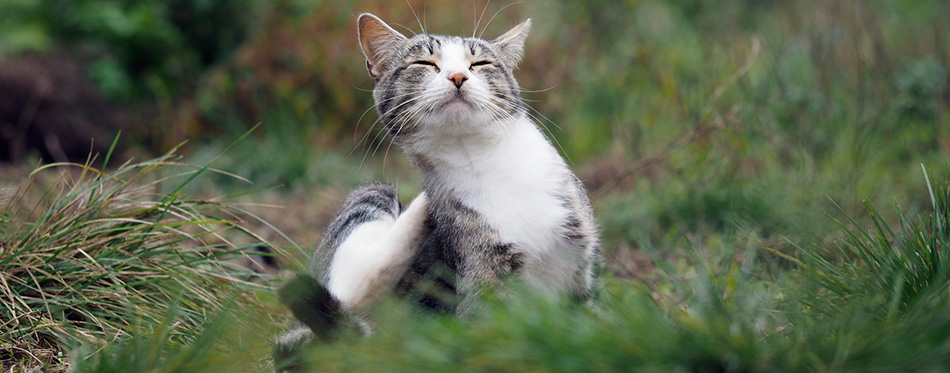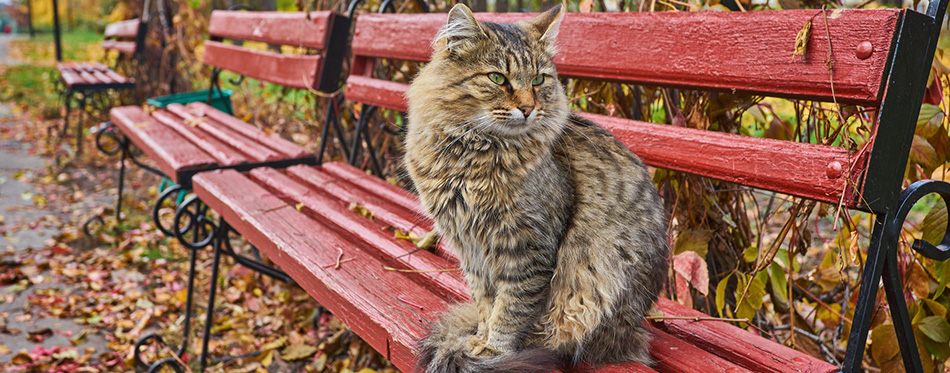Fleas can be one of the downsides of life with a cat and left untreated are a real distraction for both you and your pet. The cat flea is the most common type of flea and not only causes irritation but can also carry diseases as well as lead to long-term skin allergies in your cat.
While there are many over-the-counter solutions to your cat flea problem, there are also more natural and environmentally friendly approaches you can take without turning to harsh or potentially toxic chemicals. We take a look at the best ways to get rid of cat fleas naturally.
What are Cat Fleas
The most common type of cat flea is the Ctenocephalides felis, although rabbit and hedgehog fleas are also known to like to hitch a ride on your feline’s fur. Around 1-2mm long, cat fleas are dark brown in color and feed on your pet’s blood. They also use the safe confines of your cat’s coat – especially the neck area – to lay their eggs.
Fleas will thrive in warm, humid environments and so late summer is the peak season for infestation, although central heating and warm, cozy homes can make it a year-round problem for your pet.

How to Tell Your Cat Has Fleas
The first and most common sign your cat has fleas is excessive scratching and grooming. Take a closer look at the skin or run a flea comb through the fur and you will see tiny black dots – a sure sign that fleas have made your cat their home. These black dots are known as flea dirt and is most made up from dried blood the flea has taken from your cat. Tiny black moving dots around the base of your cat’s tail, on their neck or under the armpits are also sure signs you have a flea problem.
Understanding the Flea Life Cycle
Knowing the life cycle of the cat flea is going to make it easier to irradiate them naturally as you not only need to remove the flea but also catch their eggs. There are four stages to the cat flea – adult, egg, larva and pupa. Adults fleas feed on their host’s blood and live for around four-six weeks. Adult females can lay 20-40 eggs a day during their lifespan and you also need to deal with the eggs if your cat and home are to remain flea free. The flea eggs fall off the host, and end up in your carpet, sofas, floorboards and in the ground, where they hatch after two days. The larvae cocoon until they sense the heat of a potential new host – ie. your cat – and emerge to re-infest your feline.
How to Get Rid of Fleas on Cats – the Natural Way
Your natural flea treatment regime needs to tackle not only a current infestation but also prevent any new fleas hitching a ride back on your pet. Here’s how:
- Prevention
Prevention is one of the best and most natural ways to halting cat fleas in their tracks. And one easy way to get rid of fleas on cats is to limit your pet’s exposure to the tricky little critters in the first place. One way is to limit your cat’s time outdoors and keep them inside. Always remove your shoes before you come inside your home, to reduce the risk of tracking fleas into your house and avoid contact between your cat and other domestic animals, such as dogs. If this sounds a little restrictive, then following the below can really help to naturally eradicate fleas from your cat’s life and keep it that way.
- Comb away
A flea comb is a practical and natural way to get rid of your cat’s fleas without using any chemicals. The trick is to comb the fur slowly and thoroughly and pay special attention to the back of the head, groin, armpit and base of the tail, where fleas congregate. Dunk the comb in a bowl of soapy water to drown the fleas as you remove them and aim to flea comb your cat around twice a day until their fur runs clear of fleas.
- Washing
One of the best ways to get rid of fleas is a bath so if your cat can tolerate water then this is a good way to go. Use a non-chemical shampoo that has natural oils to repel fleas such as citrus, eucalyptus or lavender. A mild solution of apple cider vinegar in the water can also help rid the skin of fleas. Lather up your cat’s fur, paying particular attention to the fleas’ favorite hangouts of neck, groin, base of tail and armpit then rinse thoroughly with warm water. Check out our guide on the best flea shampoo for cats for more info.
- Natural treatments
There are other natural flea killers for cats which you can use, especially if your feline hates a bath. Here’s a few home remedies for fleas on cats:
Cedar chips: Fleas detest the smell of cedar so spread chips around the garden and use a natural cedar oil spray on your cat’s fur or collar to keep the critters at bay. Take a look at our review of flea collars for cats for more options.
Lemons: Citric acid is one of the most effective natural flea zappers so make up a solution by boiling a cut lemon and let it steep for a few hours before pouring the strained liquid into a spray bottle and apply to their fur. You can also add the solution to the laundry when you wash your cat’s bedding. Diluted lavender and chamomile also work in a similar way.
Herbs and spices: You can raid your kitchen cupboard for condiments that will get those fleas running for the hills. The natural compounds in oregano is effective in repelling fleas so can be used as a solution in olive oil and applied to your cat’s flea hot spots. Rosemary also works well as does a mild solution of cumin.
Salt: Salt is really effective in drying out the fleas and can also be used by sprinkling across your carpet to deal with their eggs.
You may also like our article on Flea Treatments For Cats.

De-flea Your Home
As well as your cat, you also need to de-flea your home to prevent re-infestation. Daily vacuuming of your carpets, soft-furnishings, rugs, even your bedding will go a long way to keeping those fleas away. Focus on your fur baby’s favorite curl up spots as well as their own bedding. Be consistent and thorough with your cleaning over several weeks and, combined with prevention methods as well as de-fleaing your cat, you should soon have a pest-free home. Maintain your cleaning vigilance to keep it this way. For an easier clean up, check out our review of vacuums for pet hair.
Treat Your Yard
As well as inside, make sure you de-flea your outdoor space or yard if you think fleas are being tracked in from outside. Keep ground debris and leaves to a minimum and plant fragrant herbs such as lavender or fennel to stop fleas in their tracks. You can also sprinkle a natural product called Diatomaceous earth – or DE – in the soil and around the yard. Made from fossilized algae remains, the DE dehydrates fleas when they come in contact with it, so a perfect anti-flea natural solution. Sprinkle DE in your puss’s main hang out places – it can even be used inside the home, simply vacuum it up after a few days to kill any baby fleas and break the re-infestation cycle.

